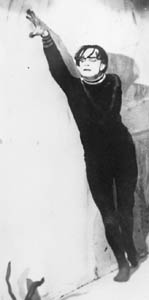![[MetroActive Music]](/gifs/music468.gif)
[ Music Index | Santa Cruz | MetroActive Central | Archives ]
Cabinet Music
New Music Works transforms Club Foot Orchestra's score for silent classic 'Caligari'
By Richard von Busack
A PLAGUE OF encephalitis, known as sleeping sickness, struck the world shortly after World War I. The memory of the epidemic survives as backstory to a classic of avant-garde film, The Cabinet of Dr. Caligari. In 1919, German director Robert Wiene conceived of the idea of the screen's first human zombie. He was a sleeping-sickness sufferer named Cesar (the devilishly handsome Conrad Veidt). Cesar is controlled by a depraved carnival barker/psychiatrist named Dr. Caligari. At night, Cesar does the doctor's bidding and murders for him.
In hindsight, Cesar seemed to anticipate how the German people would be hypnotized by a terrible mountebank into carrying out the crimes of World War II. The Cabinet of Dr. Caligari, with its shadows and radical angles, introduced the world to cinematic expressionism, and it anticipated the dark undertones in films from Citizen Kane to Batman to The Fight Club, itself a story of a kind of sleeping sickness.
Richard Marriott and his band, the Club Foot Orchestra, proposed to score Wiene's classic in the late 1980s. The loosely knit ensemble, informally connected to a tiny Third Street San Francisco nightclub called Club Foot, sometimes included Residents sideman Phil "Snakefinger" Lithman and the clarinetist/composer Beth Custer.
The soundtrack was recorded on May 2, 1988, from 3 to 6am, and it contains elements of popular music as performed during a sleepless night. Rattling snare drum solos break out of the klezmerian strife of woodwinds and violins. You can hear Vegas brassiness, haywire feedback and New Orleans funeral music for the walk of the living-dead Cesar. Having a weakness for pretty music, my favorite is the love theme: a valse triste, a ripple of marimba and Gypsy violin and flute, told and retold throughout the score, then at last mocked by acid-bent electric guitar.
"The mood is gay or sentimental, demonic or erotic, never too far from humor or madness," Marriott wrote in 1988. "There is a wonderful feel for rhythm which rushes toward the inevitable. There is a hidden political statement."
Now, Marriott is returning to this early material to reorchestrate it for Santa Cruz's New Music Ensemble and their concert Reel Time. This new version includes a harp and mandolin. A scheme that gives some transparency to Club Foot's more big-band-sounding score. For this performance, the 11-member NMW's ensemble has also added a trumpet.
As a musical experience, the Caligari score augments the terrors of a film hampered by age and a tacked-on sequence that includes that most rank of endings: "It was all a dream." However, I'd seen Caligari about a half-dozen times, and it wasn't until hearing the live Marriott/CFO score that the smug silent cackling of Werner Krauss' loathsome Caligari was enraging instead of just quaintly sinister. Maybe this was the hidden political statement Marriott meant, because Caligari at last really seemed like Hitler's herald. There's something worse than having the lunatics in charge of the asylum.
For Reel Time, New Music Works will accompany a screening of Caligari, along with live commentary by local film expert Morton Marcus, who will appear as Carl Mayer, the film's screenwriter. In addition to Caligari, the program also includes Phil Collins' score for experimental filmmaker Maya Deren's At Land, with mezzo-soprano Rita Lilly.
Man Rya's Dadaist romp Les Mystères du Château du Dé will be accompanied by Jon Scoville's frolic score. The program concludes with Erik Satie's Musique D'Ameublement (Furniture Music).
[ Santa Cruz | MetroActive Central | Archives ]
Copyright © Metro Publishing Inc. Maintained by Boulevards New Media.
![]()
 Angle of No Repose: The slanted world of 'The Cabinet of Dr. Caligari' introduced expressionism to film.
Angle of No Repose: The slanted world of 'The Cabinet of Dr. Caligari' introduced expressionism to film.
Reel Time takes place Sunday (April 29) at 8pm at the Music Recital Hall, UCSC, and on May 6 at 8pm, Louden Nelson Theater, 301 Center St., Santa Cruz. Tickets $13/$15. (429.2277)
From the April 25-May 2, 2001, 1999 issue of Metro Santa Cruz.